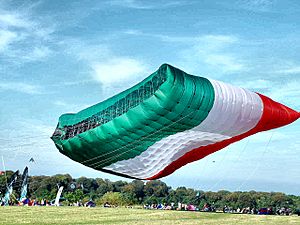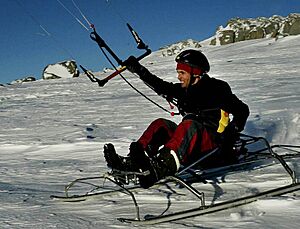Peter Lynn facts for kids
Quick facts for kids
Peter Lynn
|
|
|---|---|
| Born | 1946 (age 78–79) |
| Nationality | New Zealander |
| Occupation | Kite Maker |
| Years active | 1973–present |

Peter Lynn (born 1946) is a famous New Zealand kite maker. He is also an engineer and inventor. Peter Lynn is known for building the world's largest kites. Many of his kites hold Guinness book of records titles.
He also created huge inflatable display kites. One well-known kite is a 27-meter-long octopus. Peter Lynn helped make kite buggying popular. He also contributed a lot to power kiting and kitesurfing. He travels the world to show off his amazing kites.
Contents
Starting a Kite Business
In 1971, Peter Lynn and his wife, Elwyn, started a kite business. They set it up in Ashburton, New Zealand. At first, they made simple single-line kites for kids. In 1974, Peter Lynn invented the Peter Lynn Triangular box kite. This was a single-line kite with a special triangular shape.
Giant Display Kites
Peter Lynn began making huge creature-themed kites in 1984. His first design was a "Centipede" kite. These large kites were made for international kite festivals. They are special because they don't have a solid frame. Instead, they are inflated by the wind. Some of his famous designs include manta rays, octopuses, and geckos.
Inventing Kite Buggying
In 1987, Peter Lynn started working on power kites. These kites are strong enough to pull things. He designed boats, buggies, and snow sleds to use with them. The sport of kite buggying began from one of his inventions. He first made a kitesailing craft with three 'skis'. It did not work well on water.
In 1990, he changed it into a land buggy. He replaced the skis with wheels. Now, more than 10,000 of his buggies are used worldwide. Many other companies also make kite buggies. Kite buggying has become a very popular sport.
Strong Kite Materials
In 1994, Peter Lynn developed a new way to build kites. It is called the 'super-ripstop/thru cord' system. This system is used for large display and power kites. It makes ripstop nylon fabric much stronger. He sews special cords like dacron or spectra/dyneema across the material. These cords help the kite keep its shape in the wind.
Building the World's Largest Kites
In 1995, Peter Lynn designed the "Megabite" kite. This kite was 635 square meters big. In 1997, Guinness World Records named it the world's largest kite. More than 1000 people could walk around inside it when it was on the ground.
He also designed the current Guinness record holder. This kite is a 1019 square meter Kuwait flag. It broke the Megabite's record in 2005. That same year, he built two more huge kites. These were the "Mega Flag" in the United States and "Mega Moon" in Japan. This allowed his giant kites to be shown at more events.
New Kite Designs
In 1997, Peter Lynn created the first 'hybrid' traction kite. This kite uses both wind power and a flexible frame. Traditional power kites use either a stiff frame or air-filled sections.
In 1999, he invented the first 'bridleless arch style' ram air kite. This kite was mainly for kitesurfing. Arc style kites are very efficient. They perform well even in windy conditions. They are also more stable than other kites.
KiteSled for Snow Adventures
Peter Lynn also developed the KiteSled. This invention helps people travel on snow using kite power. The KiteSled steers by bending its skis. The skis are made of many parts fitted together.
In May 2006, two Australians, Patrick Spiers and Ben Deacon, used KiteSleds. They completed a 700 km journey across Greenland. They believed it was 20% faster than kite skiing.

Scientific Contributions
Peter Lynn has also written scientific papers. These papers explain how kites fly. His work helps others understand kite design.
Patents
- U.S. Patent 7,014,149 Traction kite design, filed April 2002, issued March 2006
- U.S. Patent 6,837,463 Ram air inflated wing, filed November 2002, issued January 2005


